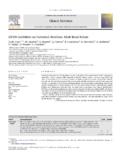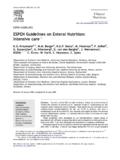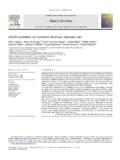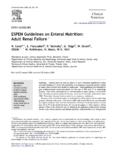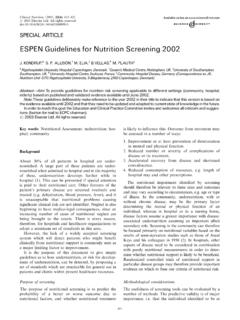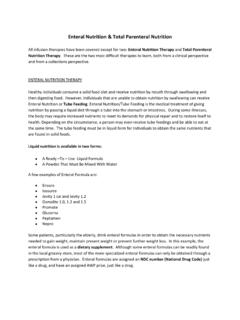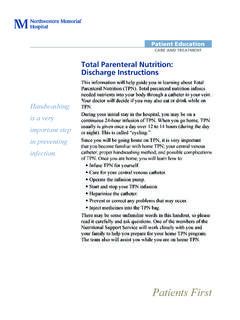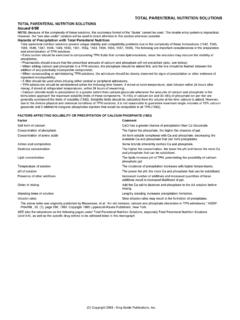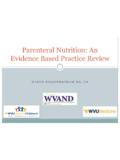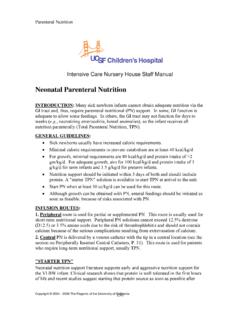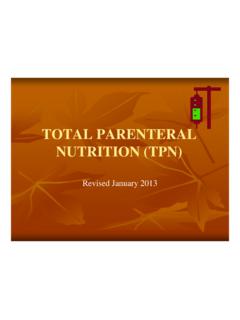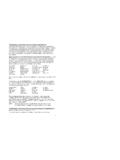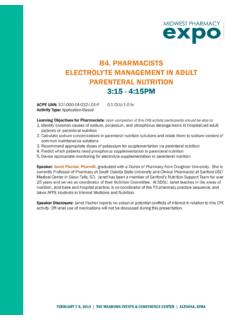Transcription of ESPEN Guidelines on Parenteral Nutrition: Home Parenteral ...
1 ESPEN Guidelines on Parenteral nutrition : Home Parenteral nutrition (HPN) in adult patientsMichael Stauna, Loris Pironib, Federico Bozzettic, Janet Baxterd, Alastair Forbese, Francesca Jolyf,Palle Jeppesena, Jose Morenog, Xavier He buterneh, Marek Pertkiewiczi, Stefan Mu hlebachj,Alan Shenkink, Andre Van GossumlaDepartment of Medical Gastroenterology, Rigshospitalet, Copenhagen, DenmarkbCentre for Chronic Intestinal Failure, University of Bologna, S. Orsola-Malpighi Hospital, Bologna, ItalycDepartment of Surgery, Hospital of Prato, Prato, ItalydScottish National Network, Ninewells Hospital and Medical School, Dundee, UKeDepartment of Gastroenterology & Clinical nutrition , University College London, London, UKfDepartment of Gastroenterology and Nutritional Support, Ho pital Beajon, Clichy, FrancegNutrition Clinic, Hospital Universitario 12 de Octobre, Madrid, SpainhDepartment of Gastroenterology and nutrition , Ho pital de l Archet, University of Nice, Nice, FranceiDepartment of nutrition and Surgery, Orlowski University Hospital, Warsaw, PolandjHospital Pharmacy, Kantonsspital Aarau, Aarau, SwitzerlandkDepartment of Clinical Chemistry, Royal Liverpool University Hospital and University of Liverpool, Liverpool, UKlClinic of Intestinal Diseases and Clinical nutrition , Ho pital Erasme, Brussels, Belgiumarticle infoArticle history.
2 Received 4 February 2009 Accepted 1 April 2009 Keywords:GuidelinesClinical practiceEvidence basedParenteral nutritionHome careHome Parenteral nutritionIntestinal failureInflammatory bowel diseaseMalabsorptionIntravenous proceduresCentral linesLine sepsisNutritional requirementsIntestinal transplantationSecondary osteoporosisMetabolic liver diseasesummaryHome Parenteral nutrition (HPN) was introduced as a treatment modality in the early 1970s primarily forthe treatment of chronic intestinal failure in patients with benign disease. The relatively low morbidityand mortality associated with HPN has encouraged its widespread use in western countries. Thus there ishuge clinical experience, but there are still few controlled clinical studies of treatment effects andmanagement of complications. The purpose of these Guidelines is to highlight areas of good practice andpromote the use of standardized treatment protocols between centers.
3 The Guidelines may serve asa framework for development of policies and procedures. 2009 European Society for Clinical nutrition and Metabolism. All rights Indication for home Parenteral nutrition (HPN)? Home Parenteral nutrition support should be used in patientswho cannot meet their nutritional requirement by enteral intake,and who are able to receive therapy outside an acute care settingLong-term PN is indicated for patients with prolongedgastrointestinal tract failure that prevents the absorption ofadequate nutrients to sustain life. As it is a life-saving therapy forpatients with irreversible intestinal failure, it does not requireevaluation of efficacy by randomized controlled trial. Its ability tomaintain quality of life and promote rehabilitation supports theuse of home :Intestinal failure is defined as a condition withreduced intestinal absorption to the extent that macronutrient and/or water and electrolyte supplements are needed to maintainhealth and/or growth.
4 Intestinal failure is severe when parenteralE-mail lists available atScienceDirectClinical Nutritionjournal homepage: $ see front matter 2009 European Society for Clinical nutrition and Metabolism. All rights nutrition 28 (2009) 467 479 Summary of statements: Home Parenteral nutrition (HPN) in adult patientsSubjectRecommendationsGradeNumbe rIndicationsHome Parenteral nutrition support should be used in patients who cannot meet their nutritionalrequirement by enteral intake, and who are able to receive therapy outside an acute care cancer patients may enter a HPN program if they are unable to meet their nutritionalrequirements by oral or enteral route and there is a risk of death due to malnutrition. It is nota contraindication for HPN that oncologic treatment has been is not recommended for patients with incurable disease and a short nutrition support team in HPNThe expertise of a nutrition support team (NST) is recommended for of HPNThe electrolyte composition of the HPN regimen should reflect fluid total calories should normally be 20 35 kcal/kg per non-protein energy provision should be 100 150 kcal for every gram of nitrogen in the HPN.
5 Unstressed adult HPN patient will require g amino acids/kg per long-term HPN treatment (>6 months) the provision of intravenous lipid should not exceed1 g/kg per day. Essential fatty acids should be daily requirement for essential fatty acids is 7 10 g, which corresponds to 14 20 g LCT fatfrom soya oil and 30 40 g LCT fat from olive/soya and fish oil emulsions also appear safe and catheters and devicesTunneled central catheters are used, as permanent access is required for long-term ports are an acceptable are intended for shorter-term use and cannot be recommended for HPN administration of Parenteral nutrition is use of infusion pumps is recommended, but is not practiced in all European prognosis in HPNP rognosis in HPN is mainly governed by the underlying disease, but poor outcomes related tothe HPN itself come from problems with catheters and the associated vessels.
6 It is important topreserve lines and to protect the vessels as best possible. Reference should be made to the ESPEN Guidelines on central venous catheters. In line sepsis in HPN a conservative approach with antibioticsis normally advocated before removing the and trainingThere should be a formal teaching program for the patient and/or carer. The teaching programshould include catheter care, pump use, and preventing, recognizing and managing nurses are usually best placed to take responsibility for the teaching use of specific brochures or videotapes for teaching, and affiliation with national supportorganizations, are associated with better is usually carried out in an in-patient setting, but training at home can be and anthropometry should be measured at all visits; measurement of trace elementsand vitamins are recommended at intervals of 6 months. Bone mineral density assessment by DEXA scanning is recommended at yearly disease in HPNHPN-associated liver disease is related to the composition of the HPN and to the underlying diseaseor coexisting liver disease.
7 The fat/glucose energy ratio should not exceed 40:60 and lipids shouldcomprise no more than 1 g/kg per forms of over-feeding should be administration in excess of 7 mg/kg per min, and continuous HPN are also considered of chronic cholestasis is of utmost importance. Infections, in particular line sepsis mustbe promptly controlled to help prevent deterioration of any liver of underlying diseaseUnderlying disease related factors must be strictly controlled, by treating inflammation andminimizing the dosage of bone damaging of the nutrientadmixture during chronic careAluminum contamination of HPN should be less than 25mg/lThe amount of sodium should be no more than required, to avoid sodium induced hypercalciuriaThe calcium, magnesium and phosphate content of the HPN should maintain normal serumconcentrations and 24-h urinary recommended ratio is 1mmol of calcium to 1mmol of amount of amino acids prescribed should not be greater than losses, in order to recommended intravenous dose of vitamin D is 200 vitamin D withdrawal in patients with low bone mineral density (BMD)
8 , low serumparathyroid hormone, and 1,25-dihydroxyvitamin D concentrations associated with normal 25-hydroxivitamin infusion rates may decrease (such as clodronate 1500 mg iv or pamidronate 20 mg iv every 3 months), maymaintain BMD in patients with transplantation inHPN patientsThe indication for intestinal transplantation is irreversible, benign, chronic intestinal failureassociated with life-threatening complications of HPN. Present data do not support direct referral forintestinal transplantation of patients with high risk of death due to underlying disease, chronicdehydration or significantly impaired quality of life. In all patients an individual case-by-casedecision is timing of patient referral is key to obtaining best graft and patient survival. Early referral isrecommended to minimize mortality from HPN related complications whilst on the waiting highest survival rates are observed among younger individuals, those at home rather than inhospital, and in patients managed in experienced transplant centers.
9 There has been steadyimprovement in patient and graft Staun et al. / Clinical nutrition 28 (2009) 467 479468nutrition and or additional Parenteral electrolytes and water 3 The condition may be transient if gut function can berestored, but HPN is indicated for patients with chronic intestinalfailure. The most common underlying diseases are inflammatorybowel disease, complications following surgery, mesentericvascular disease, radiation enteritis, and chronic small boweldisease with severe malabsorption and dysmotility syndromes. Theindication for HPN in patients with chronic intestinal failure typi-cally will be short bowel syndrome, fistula, bowel dysmotility andradiation incidence and prevalence of HPN varies across Europereflecting different organizational structures and treatment strat-egies. Reported data include HPN provided to patients with activecancer. The annual incidence for benign disease can be estimated tobe about 4 6 per million; the prevalence ranges from 2 to 40 ,5 Chronic intestinal failure may be associated with life-threat-ening complications and the condition itself is highly disabling andimpairs the quality of life.
10 The basic goals of medical treatment areto maintain fluid, electrolyte, and nutrient balance and to minimizethe risk of side effects. The overall 5 year survival for patients withbenign disease on HPN is about 75% depending on the underlyingdisease, age of the patient and gut anatomy. Patients usuallysuccumb to their underlying disease rather than to complications 8 With surgical reconstruction when feasible, from intestinaladaptation, from the future development of medical therapies (suchas growth hormone and glucagon-like peptide-2 analogues9 11)andwith improvements in the outcome of small bowel transplantation, gut anatomy as well as its function is important in determiningthe likelihood of each of these. Patients with short bowel may beconsideredinthreemainanatomictypes:end -jejunostomy(typeI,nocolon in continuity), jejuno-colonic (type II, some part of the colon incontinuity), and in jejuno-ileal (type III, the full colon in continuity).
